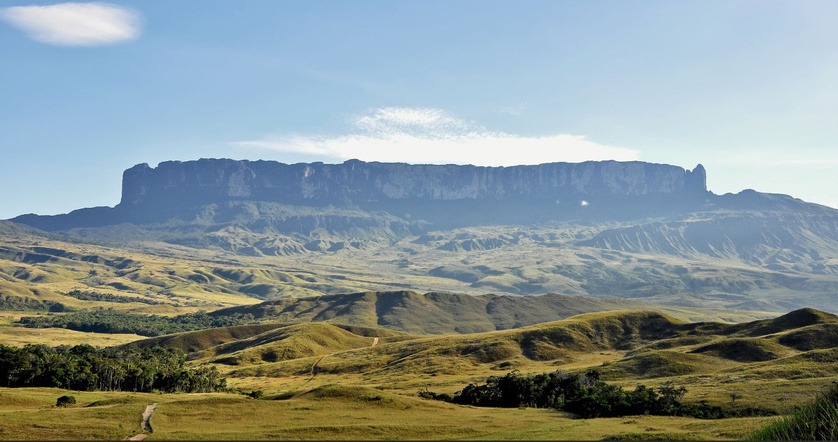What's going on at its summit?
On the border of three countries—Venezuela, Brazil, and Guyana—stands a mountain best treated with caution. Its flat summit reaches into the clouds, and its sheer walls seem to have been carved by a giant knife. The indigenous peoples called it the home of the gods and tried to avoid it. Modern travelers call Roraima "the lost world"—the very same one that inspired Conan Doyle's novel. But the more scientists study this mountain, the stronger the feeling that everything here operates by different laws—even time.
A Mountain Without a Summit
Roraima isn't your typical pyramid of mountain slopes. It's a plateau, 34 square kilometers in area, rising 2.7 kilometers above sea level. On all sides are nearly vertical walls, from which hundreds of waterfalls tumble. From below, the mountain appears to float in mid-air.
Such formations are called "table mountains." They are composed of ancient sedimentary rocks, and their flat, "table-like" surface is the result of millions of years of weathering. Roraima is the largest of them, a veritable stone fortress, formed approximately two billion years ago after a powerful earthquake.
But it wasn't its geology that made it a legend. Its mystique lies in the fact that for centuries even the bravest feared to climb it.
A Mountain Where the Gods Live
The Pemon and Capon tribes, who lived at its foot, considered Roraima sacred. They believed that this was once the trunk of a gigantic, magical tree from which all the fruits and plants of the Earth grew. When the tree was cut down, the world was covered by water—that's how the Indians explained the flood.
Later, Roraima was called the abode of the goddess Quin—the one who created all life. According to legend, those who dared to climb it returned different: silent, pale, as if they had brought back something forbidden to speak of.
Even today, local residents look upon this mountain with trepidation. They say that up there, the ordinary laws of nature and time no longer apply.
The First Explorers
Until the mid-16th century, Roraima was known only to the indigenous peoples. It was only in 1596 that an English explorer described it. But real exploration only began in 1884, when the first scientific expedition reached the island.
What the explorers saw stunned them. The plateau turned out to be a world unto itself: with streams, lakes, swamps, and plants found nowhere else on Earth. Scientists found the remains of unknown animals and rock paintings whose origins no one could explain.
And then something strange happened. The expedition members claimed to have gotten lost in the fog and spent only a few weeks at the top. But when they descended, it turned out that four years had actually passed.
A World Without Time
Travelers who have visited the plateau still say that everything seems different up there. Clouds lie right beneath their feet, sounds are muffled, and the sense of time seems erased. Even sundials are useless here—the clouds prevent the light from falling equally twice.
On Roraima, it can be hot one day, and then, five minutes later, torrential rain and lightning. It's precisely because of these thunderstorms that trees almost never grow here: lightning strikes directly onto the flat surface, and the marks of the impacts are still visible on the rocks.
Many plants here are carnivorous—sunflowers, bladderworts, and heliamphora. They feed on insects, and some are so large that they can even digest small amphibians. Scientists note that carnivorous species developed here precisely because of the poor soil: there are too few nutrients for them to survive in the usual way.
Living creatures found nowhere else
Roraima is like a fragment of another planet. It is home to animals found nowhere else. For example, the Guianan harlequin—a small frog that cannot jump or swim. When threatened, it curls up into a ball and rolls between rocks, escaping into a crevice.
Many insects, birds, and even plants are black—a rarity for the tropics. Scientists are still debating what this is connected with: whether it is due to the peculiarities of the climate, or to an ancient adaptation to lightning, of which there is too much here.
The Path to the Top
Climbing Roraima is difficult. There's only one gentle slope, and even that takes several days. First, you cross a river, then traverse the savannah and emerge into the tropical forest. Here, the air is humid, and the trees are entwined with vines. Tourists spend the night in tents and continue the climb in the morning.
Just before the summit, giant stone steps begin—perfectly shaped boulders, as if carved by human hands. But geologists insist these are the work of wind and water, not humans.
Rain usually falls on the plateau, so travelers are advised not to stray far from camp. The surface is riddled with crevasses, and a misstep can cause a fall of tens of meters.
Where Nature Keeps a Secret
At the very summit, there are no roads, but life exists—a unique, isolated life. Streams gurgle between the boulders, water splashes in small lakes, and mists float around, never completely subsiding.
The view from the summit is breathtaking: you can see the neighboring Mount Kukenan and the endless Gran Savana. This place is called "Roraima's window."
But despite the beauty, there's something unsettling about it. Even experienced guides say, "Don't linger. This mountain doesn't like strangers." Perhaps it's the weather. Or perhaps it's because there's a genuine sense of something ancient here, something that existed before humans.
A Fragment of an Ancient World
Geologists are certain that Roraima is part of an ancient plateau that was destroyed billions of years ago. What we see today is merely a fragment, miraculously preserved after the catastrophe.
Mystics put it differently. They believe a mountain isn't just a natural formation, but a structure left by someone higher up. And if humanity ever learns to understand the language of stones, it will be here that it will read the first page of its history.
Roraima isn't just a mountain. It's a place where the past and the present collide equally. Where every step is hard, but every minute feels like it belongs to another time.
Thank you for reading this far.




















